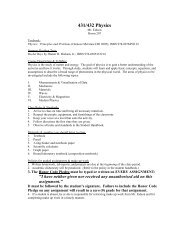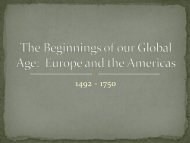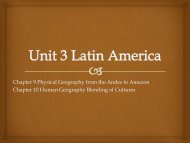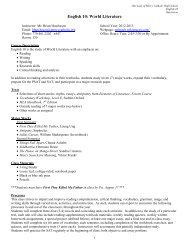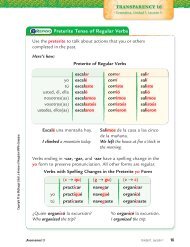The steps Involved in Protein Synthesis
The steps Involved in Protein Synthesis
The steps Involved in Protein Synthesis
You also want an ePaper? Increase the reach of your titles
YUMPU automatically turns print PDFs into web optimized ePapers that Google loves.
Prote<strong>in</strong> <strong>Synthesis</strong><br />
• Prote<strong>in</strong> synthesis is simply the "mak<strong>in</strong>g of<br />
prote<strong>in</strong>s." Although the term itself is easy to<br />
understand, the multiple <strong>steps</strong> that a cell <strong>in</strong> a<br />
plant or animal must go through are not. In<br />
order to make even one prote<strong>in</strong>, the body must<br />
seek the aid of messenger RNA, transfer RNA,<br />
DNA, am<strong>in</strong>o acids, ribosomes, and multiple<br />
enzymes. So that this process does not become<br />
too overwhelm<strong>in</strong>g, let's first go over some of the<br />
basics.
What is a Prote<strong>in</strong>?<br />
• A prote<strong>in</strong> is simply a long cha<strong>in</strong><br />
of am<strong>in</strong>o acids l<strong>in</strong>ked together by<br />
bonds. <strong>The</strong> backbone of am<strong>in</strong>o<br />
acids form strong covalent bonds<br />
and the actual am<strong>in</strong>o acids form<br />
temporary weak bonds. <strong>The</strong>se<br />
weak bonds allow the am<strong>in</strong>o<br />
acids to change shape, rema<strong>in</strong><br />
mobile, and atta<strong>in</strong> flexibility. <strong>The</strong><br />
most important quality to<br />
understand about prote<strong>in</strong>s is that<br />
the position of their am<strong>in</strong>o acids<br />
determ<strong>in</strong>e their function.
Vocabulary Review<br />
• Nucleotides: molecules that, when jo<strong>in</strong>ed together,<br />
make up the structural units of RNA and DNA.<br />
• Am<strong>in</strong>o acids: A group of 20 different k<strong>in</strong>ds of small<br />
molecules that l<strong>in</strong>k together <strong>in</strong> long cha<strong>in</strong>s to form<br />
prote<strong>in</strong>s; build<strong>in</strong>g blocks of prote<strong>in</strong>.<br />
• RNA: a nucleic molecule similar to DNA that<br />
delivers DNA's genetic message to the cytoplasm of a<br />
cell where prote<strong>in</strong>s are made<br />
• DNA: a nucleic acid that conta<strong>in</strong>s the genetic<br />
<strong>in</strong>structions used <strong>in</strong> the development and function<strong>in</strong>g<br />
of all known liv<strong>in</strong>g organisms and some viruses
<strong>The</strong> Steps<br />
• Now that we know a little about the basic<br />
structure and function of a prote<strong>in</strong>, it will be<br />
easier to understand how a prote<strong>in</strong> is made.<br />
<strong>The</strong> three basic <strong>steps</strong> of prote<strong>in</strong> synthesis are:<br />
1. Transcription<br />
2. Transferal<br />
3. Translation
A Closer Look: Transcription<br />
• In the nucleus, enzymes make a RNA copy us<strong>in</strong>g<br />
a portion of DNA. <strong>The</strong> RNA is then transformed<br />
<strong>in</strong>to a messenger RNA (mRNA). <strong>The</strong> mRNA<br />
leaves the nucleus through the pores and gets<br />
<strong>in</strong>to the cytoplasm. Here, the mRNA mixes with<br />
the ribosome, which beg<strong>in</strong>s the process of prote<strong>in</strong><br />
synthesis. So basically <strong>in</strong> this stage, RNA is<br />
created, so it can go and make <strong>in</strong>struct the<br />
mak<strong>in</strong>g of prote<strong>in</strong>.
A Closer Look: Transferal<br />
• In this stage, an am<strong>in</strong>o acid activat<strong>in</strong>g enzyme attaches<br />
an am<strong>in</strong>o acid to one end of transfer RNA (tRNA), also<br />
called an adaptor molecule. On the other end of the<br />
adaptor is a condon (a specific three-nucleotide code)<br />
which will be used when the adaptor reaches the mRNA.<br />
Once the condon is retrieved, the mRNA cont<strong>in</strong>ues to the<br />
ribosome. So basically, <strong>in</strong> this stage, an adaptor is<br />
connected to an am<strong>in</strong>o acid so it can be energized and<br />
have enough strength to cont<strong>in</strong>ue its journey.
Transferal: A Even Closer Look<br />
• Step 1: An ATP molecule lands on the<br />
activat<strong>in</strong>g enzyme <strong>in</strong> a place that is<br />
prepared for it (th<strong>in</strong>k of this space as<br />
a reserved park<strong>in</strong>g place).<br />
• Step 4: <strong>The</strong> adaptor then comes and<br />
parks <strong>in</strong> its reserved space next to<br />
the am<strong>in</strong>o acid<br />
• Step 5: <strong>The</strong> adaptor comes closer to<br />
• Step 2: An am<strong>in</strong>o acid then parks <strong>in</strong><br />
the next space which was also<br />
prepared just for it.<br />
• Step 3:<strong>The</strong> ATP molecule and the<br />
am<strong>in</strong>o acid drift closer together until<br />
they bond, which releases two<br />
phosphates. At this po<strong>in</strong>t, the am<strong>in</strong>o<br />
acid is energized.<br />
the am<strong>in</strong>o acid until they bond.<br />
• Step 6: Energy from the ATP<br />
molecule is transferred <strong>in</strong>to this<br />
bond and the ATP molecule is<br />
released.<br />
• Step 7: <strong>The</strong> activat<strong>in</strong>g enzyme<br />
f<strong>in</strong>ally releases the adaptor with the<br />
am<strong>in</strong>o acid attached to one end.
A Closer Look: Translation<br />
• At this po<strong>in</strong>t, one am<strong>in</strong>o acid is attached to an adaptor.<br />
Remember that it takes many am<strong>in</strong>o acids to make up<br />
one prote<strong>in</strong>. <strong>The</strong>refore, there must be a way to l<strong>in</strong>k<br />
these am<strong>in</strong>o acids <strong>in</strong>to a s<strong>in</strong>gle prote<strong>in</strong> <strong>in</strong> order to<br />
complete prote<strong>in</strong> synthesis. This is where the ribosome<br />
comes <strong>in</strong> which is so good at produc<strong>in</strong>g prote<strong>in</strong>s that is<br />
often termed a "prote<strong>in</strong> factory." <strong>The</strong> ribosome "reads"<br />
the start condon (AUG) and associates it with the<br />
proper am<strong>in</strong>o acid. Once all the am<strong>in</strong>o acids have been<br />
l<strong>in</strong>ked, mRNA signals STOP. <strong>The</strong> ribosome releases the<br />
mRNA and the am<strong>in</strong>o acid, and a prote<strong>in</strong> has been<br />
made.
A Closer Look: Translation<br />
• This stage is divided <strong>in</strong>to three parts: Initiation,<br />
Elongation, and Term<strong>in</strong>ation.<br />
Dur<strong>in</strong>g the<br />
<strong>in</strong>itiation<br />
phase, a<br />
ribosome<br />
attaches to the<br />
mRNA and<br />
reads the<br />
condon (AUG)<br />
Dur<strong>in</strong>g the<br />
elongation phase,<br />
tRNA br<strong>in</strong>g the<br />
correspond<strong>in</strong>g<br />
am<strong>in</strong>o acids to<br />
each codon, as<br />
the ribosome<br />
moves down the<br />
mRNA strand.<br />
Dur<strong>in</strong>g the last<br />
phase,<br />
term<strong>in</strong>ation,<br />
the molecule is<br />
read, and the<br />
synthesis ends<br />
and releases<br />
the prote<strong>in</strong>.
Very Simple Summary<br />
<strong>The</strong> <strong>in</strong>formation on DNA is copied onto an mRNA<br />
strand, which then leaves the nucleus and heads to<br />
the ribosome. Here, a tRNA molecule br<strong>in</strong>gs an<br />
am<strong>in</strong>o acid that is coded for by codons on the<br />
mRNA (codon = three base sequence). Am<strong>in</strong>o acids<br />
are bonded together as the mRNA moves through<br />
the ribosome. Am<strong>in</strong>o acids jo<strong>in</strong>ed together make a<br />
prote<strong>in</strong>.
Quiz Time<br />
1. On what cell organelle does prote<strong>in</strong><br />
synthesis occur?<br />
A. Nucleus<br />
B. Cell membrane<br />
C. Ribosome<br />
D. Golgi complex<br />
E. Smooth ER
Quiz Time<br />
2. What type of RNA molecule is made <strong>in</strong> the<br />
nucleus and carries the <strong>in</strong>formation to the<br />
place where prote<strong>in</strong>s are made?<br />
A. rRNA<br />
B. mRNA<br />
C. tRNA<br />
D. DNA
Quiz Time<br />
3. Three bases on a tRNA molecule are called<br />
a:<br />
A. Codon<br />
B. Anticodon<br />
C. Oxycont<strong>in</strong><br />
D. Trifecta
Quiz Time<br />
4. Which of the follow<strong>in</strong>g serves as an<br />
"adapter" <strong>in</strong> prote<strong>in</strong> synthesis, and bridges<br />
the gap between mRNA and prote<strong>in</strong>s?<br />
A. tRNA<br />
B. mRNA<br />
C. rRNA<br />
D. both a and b<br />
E. both a and c
Quiz Time<br />
5. <strong>The</strong> process of transferr<strong>in</strong>g a gene’s<br />
<strong>in</strong>structions<br />
for mak<strong>in</strong>g a prote<strong>in</strong> is<br />
A. translation<br />
B. replication<br />
C. transcription<br />
D. prote<strong>in</strong> synthesis




